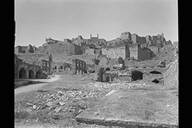
→Detailed Explanation
→The list of photos
GOLCONDA
Golconda is situated about 5 km to the west of Hyderabad old city. The Qutb Shah Dynasty, which became independent from Baihmani Dynasty in Bidar, made this city its capital after reconstructing the Hindu fort. Under the same dynasty, the palace complex was added to the fort and the city walls surrounding were arranged. The fort is situated in the southwest area within the city walls that extend about 1.5 km from east to west and north to south. The city walls have 8 gates. Outside of the east gate leading to Hyderabad, there is a large reservoir outstretching and to the northeast of the reservoir, Nizam ul-Mulk built the new fort Naya Qilah in 1724. Graveyard of the royal family of Qutb Shah extend to the north-west outside of the city walls and there remain many mausdeum. In addition, there are some mosques from the Qutb Shah period remaining inside and outside of the city walls. (Naoko Fukami)
1.FORT (12th C. rebuilt , in the last half of 14th C.)
2.IBRAHIM'S MOSQUE (1550-80)
3.TOMB OF QULI QUTB SHAH (c. 1543)
4.TOMB OF SUBHAN QULI QUTB SHAH (c. 1550)
5.BAOLI (The last half of 16th C. to 17th C.)
6.TOMB OF JAMSHID QULI QUTB SHAH (c. 1550)
1.FORT Fort Hill side and various buildings in the fort
 |
The area where
Golconda fort and its city walls exist was originally a
territory of power of Kakatiya based in Walangal in the
12th century. It was then the original form of the
current fort was built on a hill. However, at that time,
the fort was not like the current solid fort using stone
and it is said to have been a simple "kacchha"
structure using clay. Later on this hillside fort built
was obtained by Muhammad Shah I of the Baihmani Dynasty
in the late 14th century and the Golconda region was
called "Muhammadnagar" for a while. However,
the capital of the Baihmani Dynasty was in Gulbarga and
Bidar so it was in the early Qutb Shahi period after the
collapse of the Baihmani Dynasty, from the beginning to
the end of the 16th century, when the current stone-made
solid fort was built. Also the fort of "pakka"
structure, remains of which can be still seen, was built
after the period. (Matsuo Ara) →Detailed Explanation →The list of photos |
| ▲View from the south | |
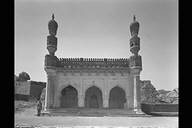 |
This mosque is
situated at the upper part of the fort, south-southeast
of Baradari at the top of Golconda fort. It was built by
the 3rd sultan of the Qutb Shahi named Ibrahim Quli Qutb
Shah (1550-80). Thus it is called by the same name. It is
a small mosque with three entrances and one span in
depth. The entire roof is surrounded by a parapet with
battlements. Two towers are located on the south and
north sides, with its bulbous-shaped dome and two
balconies so that, this mosque is in a unique style of
the medieval Deccan architecture. The central mihrab and
bays of its either sides are also unique. (Matsuo Ara) →The list of photos |
| ▲View from the east | |
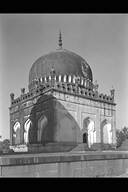 |
It is the tomb of
the first sultan of the Qutb Shahi kingdom of Golconda
named Quli Qutb Shah (1512-43). It is built on a basement
and has a dome surrounded by lotus petals. However,
compared to tombs of other sultans and royal families,
its decoration is simpler as it is a building of an
earlier period. The inside of the tomb chamber is
currently painted in white. The square chamber with
corner alcoves transformed to octagonal crossing double
or triple arches and was surrounded by a cornice with
crossed arches, transformed to a 16-gon in the second
transition. These decorations produce a unique atmosphere
of domed room. The black marble tomb stone in the centre
of the basement is the tomb of the sultan. (Matsuo Ara) →The list of photos |
| ▲View from the southwest | |
4.TOMB OF SUBHAN QULI QUTB
SHAH
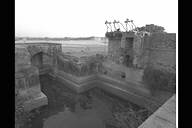 |
What is amazing in
the great fort of Golconda is its strategy for obtaining
and storing water, especially in pumping facilities and
water storage. It seems that obtaining water was one of
the most important issues for the rulers of Golconda,
itself in an important position in Deccan, being main
fort built on a hill. I introduce a well for water
storage, or baoli built within a cemetery of Qutb Shah
royal family here. It seems that a well for water
storage, called baoli in north India was also called
"wav" which includes wells furnished with
stairs. This baoli built outside the city wall has corridors with single and double arches on its two sides and it is a majestic well equipped with a square tank. It provides a proper pumping facility, one side of which has a ditch through which water is taken. The historical background of its foundation is unknown. However, judging from its style of arch, it can be seen as a building from the Qutb Shah period. It is still in use today. (Matsuo Ara) →The list of photos |
| ▲Distance view of city wall from the morth | |
6.TOMB
OF JAMSHID QULI QUTB SHAH
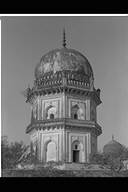 |
The tomb of the 2nd
sultan Jamshid Shah (reign 1543-50) is situated at the
south-west end of the tombs of Qutb Shahi sultans. Unlike
the other square tombs, only this tomb is octagonal with
two tiered articulation of the facade. Each tier is
surrounded by parapets with unique decorations of this
period, and each of the eight sides is decorated by a
double arch. On the top tier, there is a small tower in
the corner. However, the dome is not different from that
of other tombs. Tombs built on an octangular plan are
rare within Deccan architecture. Inside the tomb chamber,
surrounded by noble niches with triple arch, there are
three tomb stones, the biggest of which belongs to this
sultan. (Matsuo Ara) →The list of photos |
| ▲View from the south | |